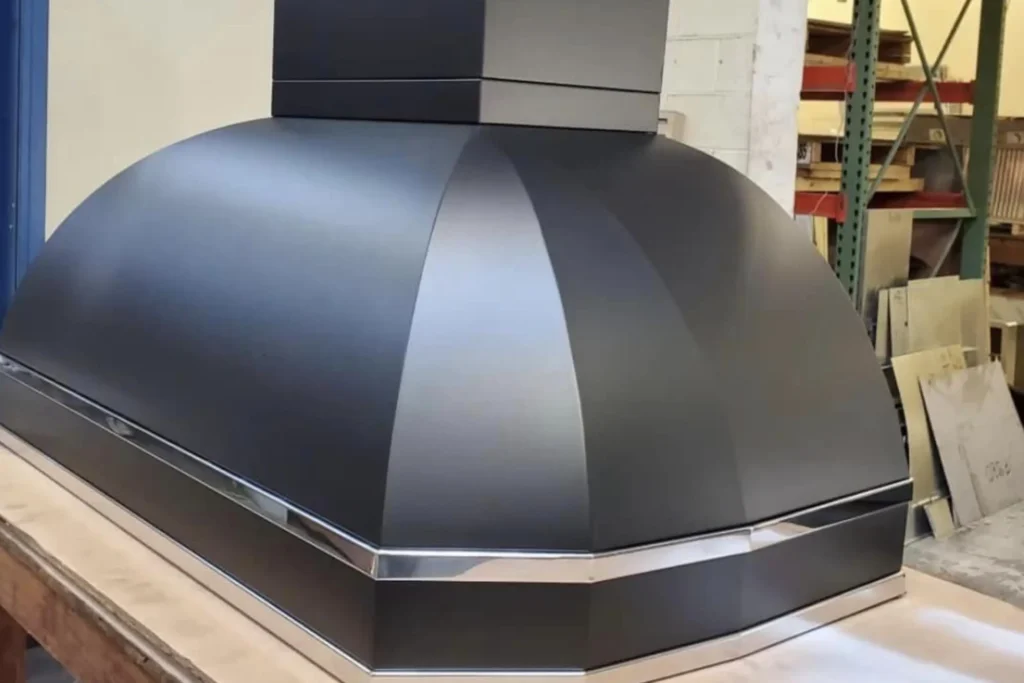Given the variations in culinary needs, advised by the frequency of your cooking, the ventilation power of the equipment, and the kitchen size, different hood sizes serve distinct kitchen environments.
The size that works for a given commercial premises is different from what works for another one.
Understanding the various sizes available in the market is integral to achieving a clean, functional, and enjoyable kitchen. Coming down to sizes, there are standard and custom sizes for your consideration.
However, this article gives an overview of the various sizes to help you pick the appropriate one that brings out your forte in cooking.

Custom range hood of your choice
Standard Widths
4 Feet
Measuring only 48 inches, these are the smallest standard hood sizes available in the market today. Given the small size, they are ideal for small cooking lines or single-coking appliances like fryers or small griddles where controlled ventilation is needed.
5 Feet
It comes with a standard width of equivalent to 60 inches. A bit larger than 4-feet standard-size hoods. It is suitable for moderate-sized cooking equipment like ranges and multiple small appliances where stronger ventilation power is required.
6 Feet
Standing at 72 inches of standard width, a 6-feet hood size is often used for larger cooking lines or a combination of multiple appliances like fryers, grills, and ovens where much more ventilation power is called for.
7 Feet
This is the second largest hood size available in the market in terms of standard width. Measuring at an equivalent of 84 inches in width, this hood size is designed for extensive cooking lines, often in busier kitchens with multiple high-output appliances.
8 Feet
At 96 inches and beyond, this range hood size is the largest in width, making it ideal for large commercial kitchens with multiple cooking stations or in custom installations like hotels, fries joints, and hospitals.
Depth
48 Inches
This depth-size hood is the most common for commercial kitchens, providing average coverage for standard appliances.
54 Inches
This one offers additional coverage, especially useful for deeper cooking equipment or setups requiring more ventilation.
60 Inches
They are used when maximum ventilation and coverage are required, such as over large grills or multiple appliances.
Height
24 Inches
This standard height offers adequate ventilation for most kitchen setups.
30 Inches
Provides extra clearance for taller appliances or setups that need more airflow.
Custom Heights
Should the rest of the heights fail to meet your airflow needs, some manufacturers are willing to offer custom heights for standard width and depth to ensure that you do not miss your airflow needs.
Custom Sizes
Conversely, custom-size hoods are designed according to the owner’s specifications in standard sizes where specific sizes exist in the market. To achieve this, the manufacturer considers the customer’s range size, design, shape, preferences, and cooking frequency. With these, the manufacturer designs and constructs a range hood that perfectly aligns with the size of the range for maximum coverage and ventilation.
Type-Specific Variations
Another parameter for determining hood sizes is the specific type. In this parameter, we have these hood types:
Type I Hoods
These are designed for high-out equipment that emits grease and clouds of smoke, including fryers, grills, and ranges, which often require larger and more powerful hoods. You will likely find them in commercial kitchens such as restaurants, hotels, and hospital kitchens where intensive cooking happens.
Type II Hoods
These are used for steam and energy-emitting appliances like dishwashers and steamers and typically come in smaller sizes than type I hoods. Given their average and moderate ventilation, they can be found in residential kitchens where more cooking happens often.
The exact size you should order for your commercial premises comes down to the cooking appliances you rely on, local building codes prevailing in your location, and fire and safety regulations. However, despite this overview of hood sizes, several individuals will still encounter challenges in this selection exercise. This is especially true if interior décor and culinary practices are not among your greatest forte. One hack that often benefits everyone in such situations is involving a professional. They will walk you through every step of the appropriate hood size selection journey before performing a masterful installation. All that is required is to pick the right technician. To ensure you make the right decision, check out their reviews.
